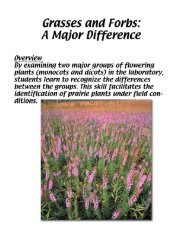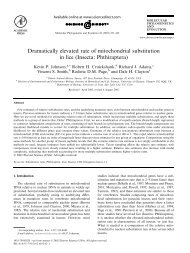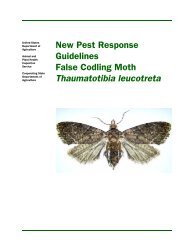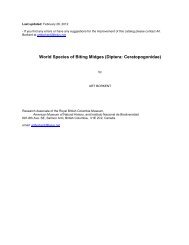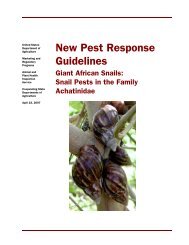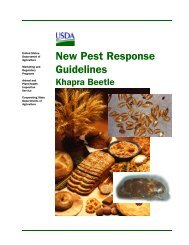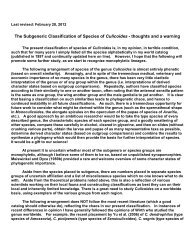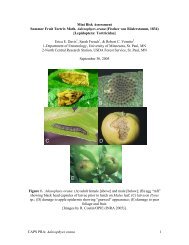Thaumatotibia leucotreta Mini Risk Assessment False codling moth
Thaumatotibia leucotreta Mini Risk Assessment False codling moth
Thaumatotibia leucotreta Mini Risk Assessment False codling moth
- No tags were found...
Create successful ePaper yourself
Turn your PDF publications into a flip-book with our unique Google optimized e-Paper software.
(Sclerocarya caffra, S.birrea), monkey pod (Cassia petersiana), oak (Quercusspp.), okra (Ablemoschus esculentus), olive (Olea europaea subsp. europaea),peach (Prunus persica), peacock flower (Caesalpinia pulcherrima),pepper/pimento (Capsicum spp.), persimmon (Diospyros spp.), plum (Prunusspp.), pineapple (Ananas comosus), pomegranate (Punica granatum), Pride of DeKaap (Bauhinia galpini), raasblaar (Combretum zeyheri), red milkweed(Mumisops zeyheri), rooibos/bushwillow (Combretum apiculatum), sida (Sidaspp.), snot apple (Azanza garckeana), stamvrugte (Chrysophyllumpalismontatum), sodom apple (Calotropis procera), sorghum (Sorghum spp.),soursop (Annona muricata), stemfruit (Englerophytum magaliesmontanum),Surinam cherry (Eugenia uniflora), suurpruim/large sour plum (Ximenia caffra),tea (Camellia sinensis), water-bessie (Syzygium cordatum), wig-‘n-bietjie(Capparis tomentosa), wild fig (Ficus capensis), wild medlar (Vangueriainfausta), wing bean (Xeroderris stuhlmannii), and yellow-wood berries(Podocarpus falcatus) (Del Valle and March 1972, Reed 1974, Schwartz and Kok1976, Daiber 1980, Bourdouxhe 1982, Anon. 1983, USDA 1984, Javai 1986, LaCroix and Thindwa 1986b, Daiber 1989, Newton 1989a, b, Silvie 1993, Zhang1994, Sétamou et al. 1995, CAB 2003).See Appendix B for a description of where host plants are grown commercially inthe continental US.3. Survey Methodology. Rating: Medium. Visual inspections of plant materialsmay be used to detect eggs, larvae, and adults of T. <strong>leucotreta</strong> (USDA 1984).Eggs will commonly be found on fruits, foliage, and occasionally on branches(USDA 1984). On citrus fruits and other fleshy hosts, dissections are needed todetect larvae; larvae are likely to be found in the pulp (USDA 1984). Infestedfruits may be on or off the tree. In cotton, older larvae may be found in open bollsand cotton seed (USDA 1984). Occasionally adults may be observed on the trunkand leaves of trees in infested orchards (USDA 1984). For field crops such ascorn, the whole plant is the recommended sample unit (Schulthess et al. 1991).Because larvae of T. <strong>leucotreta</strong> have a strongly aggregated spatial distributionamong corn plants, a large sample size (>60 plants) is recommended (Schulthesset al. 1991, Ndemah et al. 2001b); however at low densities of the pest (



